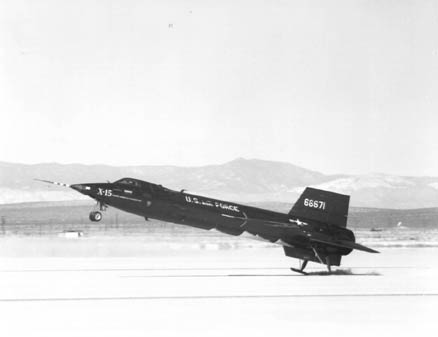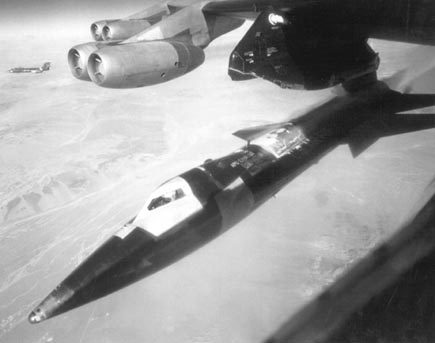X-15
America's First Spaceship
By Stephen Sherman, Mar. 2001. Updated January 26, 2012.
When it began in the early Fifties, the X-15 program was going to lead America into outer space. The pilots at Edwards Air Force would fly ever more powerful rocket planes faster and higher until, inevitably, they went into orbit. The X-15, an audacious airplane designed to fly at Mach 7, at a time when engineers were still struggling to make the X-planes behave at Mach 2, was going to be a big step toward space.
Instead, the three X-15 planes flew 199 times, reached 354,000 feet (67 miles), flew at Mach 6.7, provided invaluable research data for the Space Shuttle, and remained relatively unknown. The last X-15 flew in 1968, when the much-heralded Apollo program was taking America to the Moon.
What happened? Why did the logical, cost-effective, and far-sighted X-15 not take America into the Space Age?
Two things happened to the X-15: Sputnik and John Kennedy's commitment to put a man on the Moon by 1970.
Development and Specs
In the early 1950's, when Chuck Yeager and Scott Crossfield were flying the early X-planes (the X-1, D558-II, X-1A, and X-2), the planners at Edwards and North American Aviation designed a revolutionary new rocket plane, that would take the test pilots far above the stratosphere and into hypersonic speeds. NACA presented the final specs to the Air Force and the Navy in mid 1954, and North American was selected to develop three X-15 research planes in late 1955. In line to be the prime pilot was Iven Kincheloe, a Korean War ace, and highly regarded test pilot. Tall, blonde, and handsome, NACA and the Air Force had already nicknamed Kincheloe "Mr. Space." Tragically, Kincheloe was killed in test flight accident before the X-15 ever flew.
Fifty feet long (about as long as a P-47 Thunderbolt), with small wedge-shaped wings only 22 feet in span, the X-15 was a flying rocket engine. Like Lindbergh's Spirit of St. Louis was just a flying gas tank, so it was with the X-15 - designed and completely dedicated to a single purpose. While Lindbergh's plane was focused on flying from New York to Paris, the X-15 existed solely to test how man and machine would react to flying higher and faster than ever before.
The X-15 was powered by a rocket engine, first the "small" engine, and then by the XLR-99, a monster with 57,000 pounds of thrust, almost comparable to the Mercury Redstone rocket that launched Alan Shepard and Gus Grissom. A B-52 bomber carried the X-15 aloft, releasing it at 45,000 feet at about 500 MPH. Then the pilot switched on the rocket engine, which propelled the plane for only 80 to 120 seconds, no more than two minutes. For maneuvering at high altitudes, where there was no air for flaps and ailerons to work with, the X-15 had six small hydrogen peroxide jets, which controlled the plane's roll, pitch, and yaw. To return, the pilot had to make a dead-stick (un-powered) touchdown on the lake-bed at Edwards, just as the shuttles do today. With no brakes, the X-15 slid along for one or two miles until it slowed to a stop. Each flight lasted 10 or 11 minutes. But during the flight, each one of which followed a precise "profile," the instruments would record heat, stress, performance, etc. of the skin, the structure, the controls, and the engine.
But before the X-15 ever went up, the Russian Sputnik did in 1957, and with it rose the level of America's Cold War paranoia. The Russians were in space, preparing to dominate the high ground of World War Three. The United States had to respond; we couldn't be second to the Communists. (Just 12 years after the end of World War Two, when coming in second to the Axis would have been a tragedy to terrible to contemplate, the fears of the Fifties only seem exaggerated in hindsight.) Thus the U.S. embarked on the the MISS (Man In Space Soonest) project, which became Project Mercury. Just pack a guy into a protective "capsule" and blast into space, in a sub-orbital trajectory at first - all that could be achieved with the available Redstone rocket. In the rush to literally get "Man In Space Soonest," the carefully progressing X-15 program took second place. The nation focused on the Mercury Seven, while the pilots and engineers at Edwards continued with what they thought was the logical development of the country's aerospace capabilities.
First Flights
Scott Crossfield flew the X-15 for its first eight flights. This reflected his status among the flight test community as Chuck Yeager's successor. The first flight of an experimental aircraft was the most dangerous, the most challenging, and the most prestigious. As Tom Wolfe put it in The Right Stuff, the "righteous brethren judged each other by who got the first flight. Those who didn't were left behind." Crossfield flew the X-15 for the first time in 1959; while the speed and altitude numbers that her achieved on that flight were modest, compared to later X-15 performances, his reputation was clear. In addition to the first flight, an unpowered glide on June 8, 1959, Crossfield flew the X-15 on its first powered flight that September, and the first flight with the XLR-99 rocket engine in November 1960.
Joe Walker and Bob White were two other early X-15 pilots. Walker made the first research flight of the X-15 in March, 1960. By early 1961, Walker had taken the X-15 up to 169,600 feet (32 miles) and White had reached a speed of Mach 4.62 (3,074 MPH). Meanwhile the Mercury program struggled: rockets failed and launches were delayed. The X-15 emerged, in the public eye, as a real alternative. Bob White was pictured on the cover of LIFE magazine. An Edwards PR officer wrote a piece for Saturday Evening Post with the lead, "While the Mercury astronauts get all the headlines, the X-15 pilots do all the work," and got into deep kimchee with NASA about it.
So, what if the Mercury program had foundered? Possibly we would have redirected our focus to the X-15 and its planned successor, the X-20 Dyna-Soar. These air/space craft were re-usable, pilot-controlled, and easily could have led to a Space Shuttle-like capability much earlier than 1981. Without the long, expensive dead-end of our manned space program of the 1960s, where would we be today?
But it was not to be. On May 5, 1961, Alan Shepard rode his Mercury capsule on a brief sub-orbital trip over the Atlantic Ocean. He was received as a hero; Project Mercury was on its way. A week later, President Kennedy (with American prestige reeling from the Bay of Pigs fiasco and desperate for a diversion) made his famous speech, committing America to land a man on the Moon and return him safely to Earth before the end of the decade. Thereafter Projects Mercury, Gemini, and Apollo had unlimited funding and unlimited publicity, until in 1969, Neil Armstrong (ironically an X-15 pilot himself) stepped onto the lunar surface. The X-15 continued, in the shadow of the Moon program, until 1968.
A Typical Flight
About 45 minutes before the B-52 takeoff, the X-15 pilot climbed in, strapped in, and went through all the switches. Another 15 minutes to start the B-52 engines, and another 15 to taxi three miles to the takeoff end of the runway. After takeoff, the B-52 flew an hour to the launch point, about 250 miles from Edwards, over Nevada.
At 45,000 feet, with the B-52 flying at 500 MPH, they released the X-15 and the pilot switched on its rocket engine. Zooming up at a 35 degree angle, with a acceleration of 2 G's, the X-15 would reach 100,000 to 350,000 feet. The pilot controlled the aircraft with a right hand controller that was linked to the center stick.
Mach 6.7
The route to the fastest X-15 flight began with the crash of X-15 number 2 at Mud Lake in November, 1962. The pilot on that flight, Jack McKay, survived but was trapped underneath the aircraft and his vertebrae were crushed so severely that he lost an inch in height. The aircraft was also badly damaged and went back to North American for overhaul. During this rebuilding, the number 2 plane was re-fitted with jettisonable external fuel tanks, a ramjet engine, and an ablative coating to dissipate the extreme heat built up at hypersonic speeds.
Major Bob Rushworth flew the first flight with full external tanks (the last of his forty-five X-15 missions). Eighteen seconds after launch the flight controller radioed to Rushworth that the tanks were not transferring propellant. "We see no flow." As called for by contingency plans, Rushworth jettisoned the tanks, and made an emergency landing at Mud Lake. In November, 1966, Pete Knight took the X-15 up again, with full external tanks. They worked as planned, permitting the aircraft to achieve Mach 6.3, a record-breaking speed at the time.
On October 3, 1967, Pete Knight took it up again, and despite a slightly delayed launch, briefly hit a top speed of Mach 6.72 (4530 MPH). The aerodynamic heating at this speed far exceeded the engineering estimates and the plane's tail had partially melted and its skin had rolled back.
The End
The number 2 plane was sent for repair but it never flew again. Six month's after Pete Knight's Mach 6.7 flight, Mike Adams was killed while flying number 3. Over the next year, the number 1 X-15 flew eight more flights with the last flight occurring on October 24, 1968, the 199th flight of the X-15 program. Several attempts were made to fly the 200th flight, but to no avail. On December 20, Pete Knight was in the cockpit of the X-15 under the wing of the B-52, Balls Eight, ready to taxi to the runway when a freak snow storm moved over Edwards and the flight was canceled. Thus ended the flying portion of the most successful X-plane program in history.
Sources and Links
Edwards AFB - well-designed, easy to navigate site, good use of Flash on main page, lots of history on test pilots, airplanes, and Edwards/Muroc
|
The Right Stuff
by Tom Wolfe
Very well-written and very entertaining. The story of the guys who had "the right stuff," test pilots of the 1950's and their successors, the Mercury astronauts. |
 |



